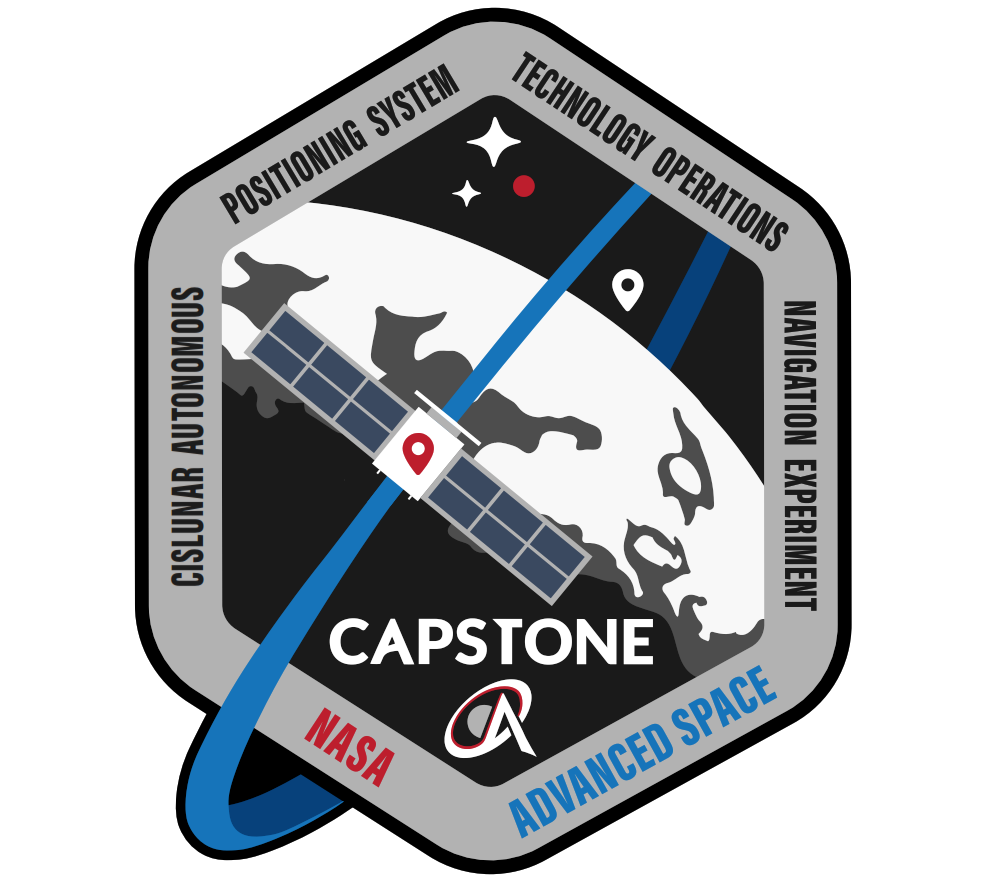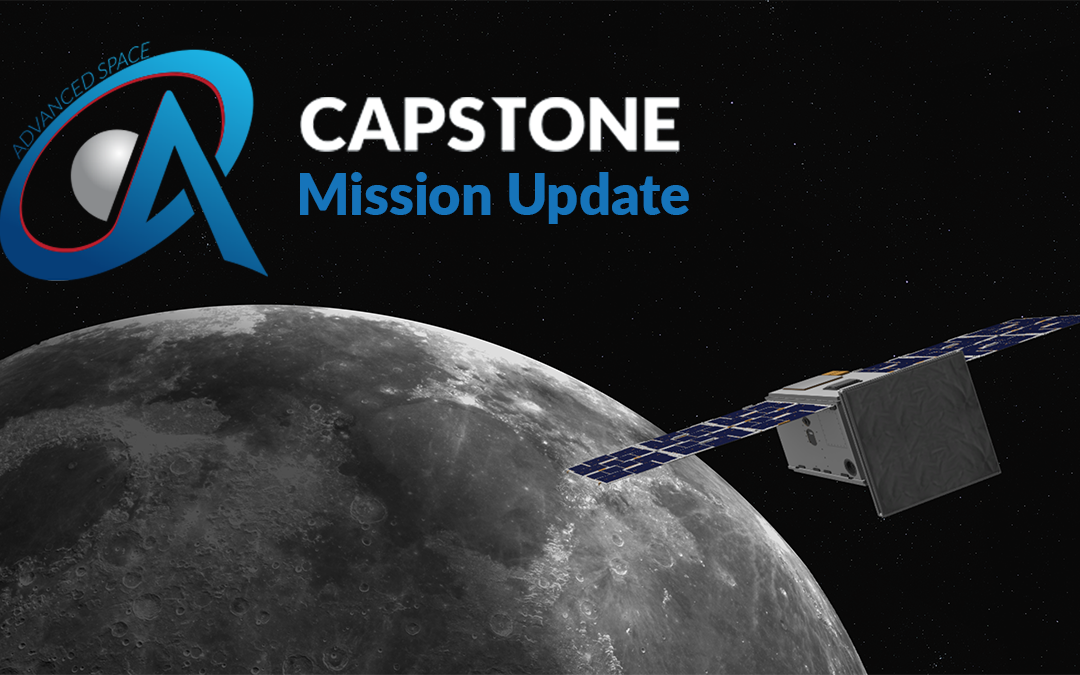Serving as an orbital pathfinder for the Gateway, the Cislunar Autonomous Positioning System Technology Operations and Navigation Experiment (CAPSTONE™) spacecraft has operated successfully for almost 300 days. During that time, the CubeSat has demonstrated its key functions, entering and maintaining its unique orbit — a near rectilinear halo orbit (NRHO) — and operating a peer-to-peer navigation technology that incorporates relative tracking between two vehicles.
NRHO provides a highly efficient path to the surface of the Moon and back, which will be used by the Lunar Gateway space station. CAPSTONE has served as a pathfinder for that orbital regime. The mission has verified the characteristics of a cislunar NRHO for future spacecraft; demonstrated spacecraft-to-spacecraft navigation services that allow future spacecraft to determine their location relative to the Moon without relying exclusively on tracking from Earth; and explored using one-way navigation through an onboard Chip Scale Atomic Clock (CSAC).
How does one-way navigation work?
Imagine being able to determine your position in space based on receiving only a signal transmitted from Earth to your spacecraft. Using a Chip Scale Atomic Clock (CSAC) included onboard, Advanced Space’s CAPSTONE spacecraft was designed to do exactly that.
We do this all the time when using the Global Positioning System (GPS). On Earth, GPS satellites each carry a highly accurate atomic clock on board. Based on the signals your phone or automobile receive from four or more satellites, it can determine where on Earth it is located along with precise time information. CAPSTONE handles this process differently: our demonstration sent a signal from a beacon (in this case, a dish from NASA’s Deep Space Network (DSN) on Earth to get measurements that were used to estimate the spacecraft’s position using statistical models and methods.
This space-based navigation approach is somewhat new, so the CAPSTONE team has been performing a series of experiments to test it out. In our experiment, DSN sends its signal to the spacecraft, and then CAPSTONE compares the time the message was sent with the time on the CSAC to calculate how far away it was from the transmitting station. The timing is measured based on the speed of light (299,792,458 meters per second or 186,282 miles per second).
Why is this important?
Normally, spacecraft navigation requires a ground station to send a signal up to each spacecraft being tracked; then each spacecraft (using a dedicated dish) returns a coherent signal back to the ground. Each ground station correlates the data using its own clock. In this way, time is synchronized on Earth and has nothing to do with the spacecraft’s onboard navigation. CAPSTONE carries its own atomic clock, which is stable enough to demonstrate how to process the DSN’s signal by itself, without help from the ground.
The one-way signaling process — designed by NASA’s Jet Propulsion Laboratory (JPL) in Southern California for CAPSTONE — should enable CAPSTONE (and future spacecraft using the Cislunar Autonomous Positioning System (CAPS™) and a CSAC) to obtain measurements without performing two-way tracking from Earth. Instead, the spacecraft would figure out where it is on its own based on the process described above. In the long term, this ability enables greater spacecraft autonomy; reduces downlink congestion and the number of dedicated antennas needed on Earth; and allows multiple spacecraft receiving the beam from the transmitting Earth station to get the data simultaneously.
What’s the Status?
Since entering our enhanced mission (after completing our six-month primary mission), we have begun ramping up our navigation experiments, such as the aforementioned one-way navigation demonstration. Many of these experiments involve the onboard radio, which recently experienced a communications issue due to a suspected problem with a solid-state power amplifier (SSPA) that is used to increase the power on the downlink signal from CAPSTONE to Earth. While this setback has a minor impact on the amount of data that can be downlinked from the spacecraft, it has no effect on the navigation experiments we plan to perform. Additionally, the spacecraft continues to operate exceedingly well in its orbit around the Moon. The remainder of the mission will continue to focus on these experiments to demonstrate unique cislunar navigation techniques that help inform future missions. We will continue to monitor the ongoing risk of subsequent degradation or failure of the communications subsystem and will share more information when we have it.
Accomplishments & Lessons Learned
Since it began operating in NRHO 275 days ago, CAPSTONE has achieved many objectives and first-of-their-kind accomplishments.
- CAPSTONE became the first commercial spacecraft and the first CubeSat to orbit the Moon and the first to use a Near Rectilinear Halo Orbit.
- The spacecraft’s journey has encompassed 40 complete NRHO revolutions around the Moon, performing 11 orbital maintenance maneuvers; four out of its five operational objectives; one successful crosslink attempt with the Lunar Reconnaissance Orbiter; and two one-way uplink passes.
- The spacecraft has completed its primary mission phase, which included 6 months in NRHO, and started its technology enhancement phase. We achieved a new maximum up time of over 1,300 hours; the current up time is over 700 hours.
- While not a primary mission objective, CAPSTONE has captured Earth and Moon images with its onboard camera, performing one Earth imaging campaign and two Lunar imaging campaigns.
- As part of the CAPS navigation activity, the spacecraft performed five crosslink attempts with the Lunar Reconnaissance Orbiter (LRO)
- Our navigation team has exceeded original expectations and as a result, we were able to reduce the number of tracking passes conducted by the Deep Space Network (DSN) from daily to 3-5 per week with reduced durations.
- The spacecraft has experienced eight eclipses by the Earth, with the shortest mission eclipse occurring 9 Aug 2023, at ~5 minutes. Eclipse durations match pre-flight predictions to within less than 1 minute.
- The mission operations team has presented 27 papers and provided mission briefings to NASA’s Johnson Space Flight Center, NASA’s Goddard Space Flight Center, and JPL.
Given all our adventures with CAPSTONE we are grateful for the participation of our partners—NASA’s Space Technology Mission Directorate, JPL, and Deep Space Network, NASA’s Ames Research Center in California’s Silicon Valley, as well Terran Orbital Corporation, Stellar Exploration, Inc, Space Dynamics Laboratory (SDL), Morehead State University, Tethers Unlimited Inc., Orion Space Solutions, and Rocket Lab—all of whom have contributed to a successful mission.
About CAPSTONE™: CAPSTONE Press Kit
CAPSTONE™ is owned and operated by Advanced Space. It is one of the first CubeSats to fly in cislunar space – the orbital area near and around the Moon – and demonstrate an innovative spacecraft-to-spacecraft navigation technology. The mission launched on June 28, 2022. Critical partners in the CAPSTONE mission include:

-
- NASA: CAPSTONE’s development is supported by the Space Technology Mission Directorate via the Small Spacecraft Technology and Small Business Innovation Research programs at NASA’s Ames Research Center in California’s Silicon Valley. The Artemis Campaign Development Division within NASA’s Exploration Systems Development Mission Directorate supported the launch and mission operations. NASA’s Launch Services Program at Kennedy Space Center in Florida was responsible for launch management. NASA’s Jet Propulsion Laboratory supported the communication, tracking, and telemetry downlink via NASA’s Deep Space Network, Iris radio design and groundbreaking 1-way navigation algorithms.
- Terran Orbital Corporation: Spacecraft design, development and implementation, hardware manufacturing, assembly, testing and mission operations support.
- Stellar Exploration: Propulsion subsystem provider.
- Rocket Lab USA, Inc.: Launch provider for CAPSTONE on a three-stage Electron launch vehicle.
- Space Dynamics Lab (SDL): Iris radio and navigation firmware provider.
- Orion Space Solutions (formerly Astra): Chip Scale Atomic Clock (CSAC) hardware provider necessary for the 1-way ranging experiment.
- Tethers Unlimited, Inc.: Cross Link radio provider.
- Morehead State University (MSU): Operates the newest “affiliated node” on the NASA Deep Space Network (DSN). Providing telemetry, tracking and control services for NASA and commercial space missions and to engage university students in deep space mission operations.
